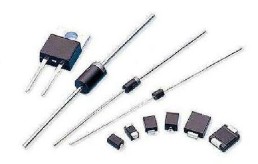A semiconductor device that converts alternating current into direct current.Usually it contains a PN junction, with positive and negative terminals.The most important characteristic of a diode is its one - way conductivity.In a circuit, current can only flow in from the positive pole of a diode and out from the negative pole.
A semiconductor device that converts alternating to direct current (dc).The most important characteristic of a diode is its one - way conductivity.In a circuit, current can only flow in from the positive pole of a diode and out from the negative pole.Usually it contains a PN junction, with positive and negative terminals.Its structure is shown in the figure.The charge carriers in the P region are holes and the charge carriers in the N region are electrons.When the applied voltage makes the voltage in the P region positive relative to the N region, the potential barrier will be reduced, and a storage carrier will be generated near the two sides of the potential barrier, which can pass through a large current and has a low voltage drop (the typical value is 0.7v), which is called the positive conduction state.If the opposite voltage is added, the barrier can be increased to withstand high reverse voltage and flow through a small reverse current (called reverse leakage current), which is called reverse blocking state.Rectifier diode has obvious unidirectional conductivity.Rectifier diodes can be made of semiconductor materials such as germanium or silicon.The silicon rectifier diode has high breakdown voltage, small reverse leakage current and good high temperature performance.High voltage and high power rectifier diodes are usually made of high purity monocrystalline silicon.The junction area of this kind of device is large, and can pass a large current (up to thousands of amperes), but the working frequency is not high, generally in the tens of KHZ.Rectifier diodes are mainly used in a variety of low-frequency half-wave rectifier circuits.
(1) maximum average rectifier current IF: refers to the maximum forward average current allowed to pass through the diode during long-term operation.The current is determined by the junction area of the PN junction and the cooling condition.Note that the average current through the diode should not be greater than this value, and to meet the cooling conditions.For example, IF of 1N4000 series diode is 1A.
(2) highest reverse working voltage VR: refers to the maximum reverse voltage allowed to be applied at both ends of the diode.If the value is larger than this value, the reverse current (IR) will increase sharply, and the unidirectional conductivity of diode will be destroyed, thus causing the reverse breakdown.Half of the reverse breakdown voltage (VB) is usually taken as (VR).For example, VR of 1N4001 is 50V, 1n4002-1n4006 is 100V, 200V, 400V, 600V and 800V respectively, and VR of 1N4007 is 1000V
(3) maximum reverse current IR: it is the reverse current allowed to flow through the diode at the highest reverse operating voltage. This parameter reflects the unidirectional conductivity of the diode.Therefore, the smaller the current value, the better the quality of the diode.
(4) breakdown voltage VB: refers to the voltage value at the sharp bending point of the diode reverse volt-ampere characteristic curve.When the reverse is a soft characteristic, it refers to the voltage value under the condition of given reverse leakage current.
(5) highest working frequency FM: it is the highest working frequency of diode under normal conditions.Mainly determined by the junction capacitance and diffusion capacitance of PN junction, if the working frequency exceeds FM, the unidirectional conductivity of diode will not be well reflected.For example, the 1N4000 series diode has an FM of 3kHz.Quick recovery diodes are also used for rectification of high frequency alternating current, such as switching power supplies.
(6) reverse recovery time TRR: refers to the reverse recovery time under the specified load, forward current and maximum reverse transient voltage.
(7) zero-bias capacitor CO: refers to the sum of the capacity of the diffusion capacitor and the junction capacitor when the voltage at both ends of the diode is zero.It is worth noting that due to the limitation of manufacturing process, the parameters of even the same type of diode are very discrete.Is often a range of parameters in the manual, if the test conditions change, the corresponding parameters will also change, such as the measured 1 at 25 ° C n5200 series silicone sealants rectifier diode IR less than 10 ua, whereas at 100 ° C IR to less than 500 ua.
Damage reason
(1) insufficient lightning protection and overvoltage protection measures.No lightning protection or over voltage protection device is installed in the rectifier device. Even if the lightning protection or over voltage protection device is installed, its work is not reliable and the rectifier tube is damaged due to lightning strike or over voltage.
(2) poor operating conditions.Indirect transmission of the generator set, because the ratio of speed is not correct or the ratio of the diameter of the two belt disk does not meet the requirements of the ratio of speed, so that the generator for a long time in a high speed operation, and the rectifier tube is also in a high voltage for a long time to work, to accelerate the aging of the rectifier tube, and was prematurely damaged by breakdown.
(3) poor operation and management.The operator on duty shall not be responsible and shall not be aware of the changes in the external load (especially between midnight at night and 6:00 a.m. the next day), or shall fail to carry out the corresponding operation and treatment in time when the external load rejection fault occurs, resulting in over voltage and breakdown damage of the rectifier tube.
(4) equipment installation or manufacturing quality is not up to standard.Because the generator set is running in the vibration for a long time, the rectifier tube is also under the external disturbance of the vibration.At the same time, because of the high and low rotation speed of the generator set, the working voltage of the rectifier tube also fluctuates, which greatly accelerates the aging and damage of the rectifier tube.
(5) the specifications and models of rectifier tubes are inconsistent.When replacing the rectifier tube with a new one, the tube whose working parameters do not meet the requirements is wrongly replaced or the wiring is wrong, resulting in breakdown damage of the rectifier tube.
(6) the safety margin of rectifier tube is too small.The over voltage and over current safety margin of the rectifier tube is too small, so that the rectifier tube can not withstand the generator excitation loop in the over voltage or over current transient process peak attack and damage.

Commonly used rectifier diode models
Mounting mode: patch power characteristic: high power
Diode model: sa5.0a/ca-sa170a /CA installation: straight plug
Diode type: IN4007/IN4001 mounting mode: direct insertion power characteristic: low power frequency characteristic: low frequency
Diode model: 70HF80 mounting mode: screw type power characteristic: high power frequency characteristic: high frequency
Diode model: MRA4003T3G mounting mode: patch
Diode type: 1SS355 mounting mode: patch power characteristic: high power
Diode model 6A10 mounting mode: direct insertion power characteristic: high power;Model: 2DHG installation mode: direct insertion power characteristic: high power
Diode model B5G090L mounting mode: direct power characteristic: low power frequency characteristic: ultra-high frequency
Maximum reverse peak voltage (v) average rectifier current (a) maximum peak surge current (a) maximum reverse leakage current (Ua) positive voltage drop (v) appearance
IN4001 50 1.0 30 5.0 1.0 DO--41
IN4002 100 1.0 30 5.0 1.0 DO--41
IN4003 200 110 30 5.0 1.0 DO--41
IN4004 400 1.0 30 5.0 1.0 DO--41
IN4005 600 1.0 30 5.0 1.0 DO--41
IN4006 800 1.0 30 5.0 1.0 DO--41
IN4007 1000 1.0 30 5.0 1.0 DO--41
IN5391 50 1.5 50 5.0 1.5 DO--15
IN5392 100 1.5 50 5.0 1.5 DO--15
IN5393 200 1.5 50 5.0 1.5 DO--15
IN5394 300 1.5 50 5.0 1.5 DO--15
IN5395 400 1.5 50 5.0 1.5 DO--15
IN5396 500 1.5 50 5.0 1.5 DO--15
IN5397 600 1.5 50 5.0 1.5 DO--15
IN5398 800 1.5 50 5.0 1.5 DO--15
IN5399 1000 1.5 50 5.0 1.5 DO--15
RL151 50 1.5 60 5.0 1.5 DO--15
RL152 100 1.5 60 5.0 1.5 DO--15
RL153 200 1.5 60 5.0 1.5 DO--15
RL154 400 1.5 60 5.0 1.5 DO--15
RL155 600 1.5 60 5.0 1.5 DO--15
RL156 800 1.5 60 5.0 1.5 DO--15
RL157 1000 1.5 60 5.0 1.5 DO--15
Ordinary rectifier diode parameters (2)
Maximum reverse peak voltage (v) average rectifier current (a) maximum peak surge current (a) maximum reverse leakage current (Ua) positive voltage drop (v) appearance
RL201 50 2 70 5 1 DO--15
RL202 100 2 70 5 1 DO- 15
RL203 200 2 70 5 1 DO- 15
RL204 400 2 70 5 1 DO- 15
RL205 600 2 70 5 1 DO- 15
RL206 800 2 70 5 1 DO- 15
RL207 1000 2 70 5 1 DO- 15
2a01 50 2 70 5 1.1 DO--15
2a02 100 2 70 5 1.1 DO--15
2a03 200 2 70 5 1.1 DO--15
2a04 400 2 70 5 1.1 DO--15
2a05 600 2 70 5 1.1 DO--15
2a06 800 2 70 5 1.1 DO--15
2a07 1000 2 70 5 1.1 DO--15
RY251 200 3 150 5 3 DO- 27
RY252 400 3 150 5 3 DO- 27
RY253 600 3 150 53 DO- 27
RY254 800 3 150 5 3 DO- 27
RY255 1300 3 150 5 3 DO- 27
General rectifier diode parameters (3)
IN5401 50 3 200 5 1 DO- 27
IN5402 100 3 200 5 1 DO--27
IN5403 150 3 200 5 1 DO--27
IN5404 200 3 200 5 1 DO--27
IN5405 400 3 200 5 1 DO--27
IN5406 600 3 200 5 1 DO--27
IN5407 800 3 200 5 1 DO--27
IN5408 1000 3 200 5 1 DO--27
6a05 50 6 400 10 0.95 R--6
6a1 100 6 400 10 0.95 R--6
6a2 200 6 400 10 0.95 R--6
6a4 400 6 400 10 0.95 R--6
6a6 600 6 400 10 0.95 R--6
6a8 800 6 400 10 0.95 R--6
6a10 1000 6 400 10 0.95 R--6
P600a 50 6 400 10 0.95 R--6
P600B 100 6 400 10 0.95 R--6
P600D 200 6 400 10 0.95 R--6
P600G 400 6 400 10 0.95 R--6
P600J 600 6 400 10 0.95 R--6
P600K 800 6 400 10 0.95 R--6
P600M 1000 6 400 10 0.95 R--6




没有评论:
发表评论